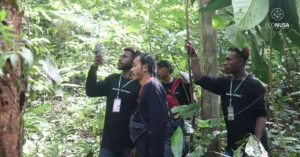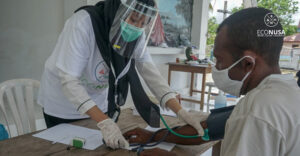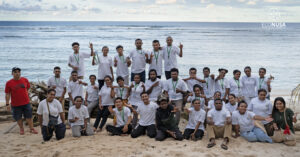
Covid-19 outbreak contagion continues its massive transmission. With the absence of vaccine or medicine, every individual should inevitably care for their own immunity. One may consume various kinds of nutritious intakes to prevent from viral contagion. Building immunity with Papuan medicinal plants can be an option to protect the body, particularly the Papuan indigenous community who has communal lifestyle but yet vulnerable to the infectivity. In the Land of Papua, there are at least 15,000 types of plants with tube which among others could provide immunity and stamina booster.
According to Lisye Iriana Zebua, an Ethnobotany lecturer at Cendrawasih University’s School of Biology, immune system is deemed defense system that could identify and wipe out strange objects or abnormal cell that are harmful to our body. To get robust supply of immunity system that could protect us from viral or bacterial contagion, immunity cell should be supplied with complete nutritious food as weapons. Vitamins A, B, C, D, and E, iron mineral, selenium, zinc, polyphenol and carotenoid are the nutrition required for immune system to battle against virus and bacteria. In fact, as from the 15,000 types of plants in the Land of Papua, many of them has those substances.
Utilization of the Papuan medicinal plants as traditional medication has been done by various tribal communities in the Land of Papua from generation to generation as it is deemed part of local wisdoms. Dani Tribe in Jayawijaya, Mee in Kamuu District, Dogiya, Mansinam Island community, Kanum in Wasur National Park are among tribal communities practicing this tradition. The Papuan communities believe that their mother nature has provided medicines for all kinds of ailments.
The efficacy of red fruit or pandanus conoideus Lam has been widely known as the remedy for various types of ailment such as cancer and diabetes. Papuan people use them for eyes, skin and neurological function health care. Besides, there are still many kinds of medicinal plants in Papua with health efficacy. Based on Medicinal Plants and Herbal Concoction research (RISTOJA) conducted by the Health Office in 2017, there are 983 types of plants in Papua that are presumably considered medicinal herbs. As from the figure, 529 types have been identified as the medicinal plants that could cure various diseases.
Ervizal AM Zuhud, Tropical Biodiversity Conservation lecturer of the Bogor Institute of Agriculture (IPB), said that foods from Papua with high content of Vitamin C are consumable for boosting immunity and protecting human body from viral-borne diseases including Corona virus. The Papuan vegetation with high Vitamin C substances include Taer fruit (Anisoptera thurifera), Waribo or forest coconut (Borassus heineanus), Piarawi (Haplolobus cf. monticola), Gayang (Inocarpus fagifer), Selre (Sararanga sinuosa), Woton (Sterculia shillinglawii), dan Matoa (Pometia pinnata).
Lisye also elaborated that the Papuan endemic plants from pandanus family are highly nutritious which is required by human body to build immunity. Some of them are Pandanus conoideus Lam (red fruit pandanus) with beta carotene (Vitamin A) and tocopherol (Vitamin E). Pandanus jiulianettii Martelli (forest coconut pandanus) has high amount of Vitamin E and antioxidant. Sararanga sinuosa Hemsley (Papuan grape pandanus) is the source of provitamin A, vitamin C, vitamin B complex, mineral, food fiber and organic acid such as citrate acid, malate acid, tartrate, oxalate, and fumarate acid.
Besides, the nutritious substance in Lagenaria siceraria (Molina) Standley or Papuan water pumpkin, Glocidion sp. (sampare leaf), and Myrmecodia sp. (ant nest) are also believed as immunity boosters. The Papuan water pumpkin, also known as the raw material for koteka, is rich with Vitamins A, B1, B2, B3 and C, proteins, calcium, phosphor, natrium, calcium, and iron. Sampare leaf is rich with flavonoid, alkaloid, saponin, tannin, and quinone which is of the same family of chloroquine. The medical plant here is part of the local knowledge for Biak peoples to cure malaria. The ant nest has multi-mineral, flavonoid, tannin and serves as natural antibiotics.
According to Simon Sutarno, an Ethnobiology lecturer of Papua University’s School of Biology, there are some kinds of medical herbs in Papua that could allegedly heal Covid-19 symptoms. The medical plants have evidently showed their efficacy to cure many ailments that are considered symptom of Covid-19. Those plants are:
- Actinidia sp., Alstonia sp. Endospermum mollucanum, Horsfieldia sp., Nuclea orientalis, and Graptophyllum pictum that could heal lung ailment.
- Pothos scandens, Begonia spp., Catharanthus roseus can be utilized as cough remedy.
- Beniacasa hispida, Pipturus repandus, Flagelaria indica, Freycinetia sp., Ceiba petandra could drop fever.
- Baringtonia asiatica, Euodia sp., Mimosa pudica could treat suffocation.
Despite the fact that the Land of Papua has remarkable richness of medical plants, it is regrettable to know that most of them is utilized traditionally by the local community. The government should have provided support for researches on the various forms of the Papuan medication plants through the universities as the frontline of studies. Ervizal believed that Indonesia could cope with the pandemic without any dependence on any overseas remedy. “This is not impossible. The local ethnobotany should get warranty that only studies that could convince the community to consume it,” said Ervizal.
Lisye similarly expressed her ideas that the Indonesian medical herbs, particularly from the Land of Papua, actually have potentials and prominence if compared to the imported medicines from abroad. “Why don’t we promote the local remedies here to tackle the Covid-19 pandemic? The only way to conquer the current pandemic is by bolstering immunity with the consumption of medicinal plants,” said Lisye optimistically.
Editor: Leo Wahyudi




